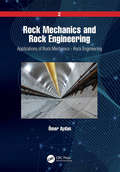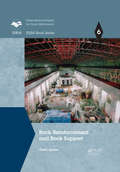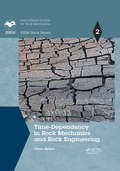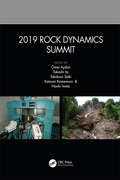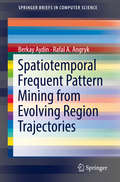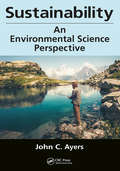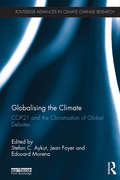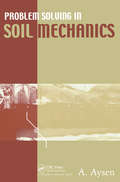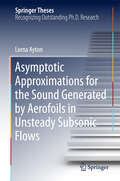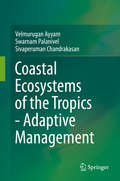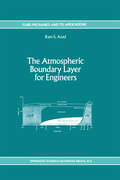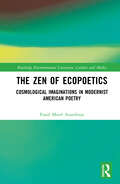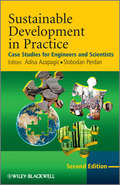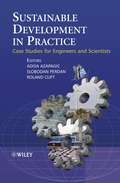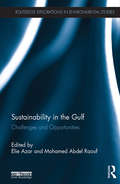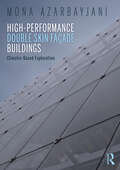- Table View
- List View
Rock Mechanics and Rock Engineering: Volume 2: Applications of Rock Mechanics - Rock Engineering
by Ömer AydanThe two-volume set Rock Mechanics and Rock Engineering is concerned with the application of the principles of mechanics to physical, chemical and electro-magnetic processes in the upper-most layers of the earth and the design and construction of the rock structures associated with civil engineering and exploitation or extraction of natural resources in mining and petroleum engineering. Volume 2, Applications of Rock Mechanics – Rock Engineering, discusses the applications of rock mechanics to engineering structures in/on rock, rock excavation techniques and in-situ monitoring techniques, giving some specific examples. The dynamic aspects associated with the science of earthquakes and their effect on rock structures, and the characteristics of vibrations induced by machinery, blasting and impacts as well as measuring techniques are described. Furthermore, the degradation and maintenance processes in rock engineering are explained. Rock Mechanics and Rock Engineering is intended to be a fundamental resource for younger generations and newcomers and a reference book for experts specialized in Rock Mechanics and Rock Engineering and associated with the fields of mining, civil and petroleum engineering, engineering geology, and/or specialized in Geophysics and concerned with earthquake science and engineering.
Rock Reinforcement and Rock Support (ISRM Book Series)
by Ömer AydanThe stability of underground and surface geotechnical structures during and after excavation is of great concern as any kind of instability may result in damage to the environment as well as time-consuming high cost repair work. The forms of instability, their mechanisms and the conditions associated with them must be understood so that correct stabilisation of the structure through rock reinforcement and/or rock support can be undertaken. Rock Reinforcement and Rock Support elucidates the reinforcement functions of rock bolts/rock anchors and support systems consisting of shotcrete, steel ribs and concrete liners and evaluates their reinforcement and supporting effects both qualitatively and quantitatively. It draws on the research activities and practices carried out by the author for more than three decades and has culminated in a most extensive up-to-date and a complete treatise on rock reinforcement and rock support.
Rock Reinforcement and Rock Support (ISRM Book Series)
by Ömer AydanThe stability of underground and surface geotechnical structures during and after excavation is of great concern as any kind of instability may result in damage to the environment as well as time-consuming high cost repair work. The forms of instability, their mechanisms and the conditions associated with them must be understood so that correct stabilisation of the structure through rock reinforcement and/or rock support can be undertaken. Rock Reinforcement and Rock Support elucidates the reinforcement functions of rock bolts/rock anchors and support systems consisting of shotcrete, steel ribs and concrete liners and evaluates their reinforcement and supporting effects both qualitatively and quantitatively. It draws on the research activities and practices carried out by the author for more than three decades and has culminated in a most extensive up-to-date and a complete treatise on rock reinforcement and rock support.
Time-Dependency in Rock Mechanics and Rock Engineering (ISRM Book Series)
by Ömer AydanThis book is concerned with time-dependency in rock mechanics and rock engineering, whose spectrum is very wide. While the term “time-dependency” involves time-dependent behavior/rate-dependent behavior of rocks in a conventional sense, this books attempts to cover the spectrum as much as possible including coupled processes of thermal, hydrological and diffusions in rocks. It presents theoretical formulations, experiments, numerical formulation and examples of applications. Of paramount concern is the long-term response and stability of rock engineering structures, including for instance man-made and natural slopes and underground facilities such as tunnels and powerhouses.
2019 Rock Dynamics Summit: Proceedings of the 2019 Rock Dynamics Summit (RDS 2019), May 7-11, 2019, Okinawa, Japan
by Ömer Aydan Takashi Ito Takafumi Seiki Katsumi Kamemura Naoki IwataRock dynamics has become one of the most important topics in the field of rock mechanics and rock engineering, and involves a wide variety of topics, from earthquake engineering, blasting, impacts, failure of rock engineering structures as well as the occurrence and prediction of earthquakes, induced seismicity, rock bursts to non-destructive testing and explorations. Rock dynamics has wide applications in civil and infrastructural, resources and energy, geological and environmental engineering, geothermal energy, and earthquake hazard management, and has become one of the most topical areas. 2019 Rock Dynamics Summit contains 8 keynote addresses and 128 regular full papers that were presented at the 2019 Rock Dynamics Summit (2019 RDS, Okinawa, Japan, 7-11 May 2019), a specialized conference jointly organized by the Rock Dynamics Committee of the Japanese Society of Civil Engineers (JSCE-RDC), the Japanese Society for Rock Mechanics (JSRM), and which was supported by the International Society for Rock Mechanics and Rock Engineering (ISRM) and the Turkish National Society for Rock Mechanics (TNSRM). The contributions cover a wide range of topics on the dynamic behavior of rock and rock masses and scientific and engineering applications, and include: - Laboratory tests on Dynamic Responses of Rocks and Rock Masses / Fracturing of Rocks and Associated Strong Motions- Estimation Procedures and Numerical Techniques of Strong Motions Associated with the Rupture of Earth’s Crust and Some Strong Motion- Dynamic Response and Stability of Rock Foundations, Underground Excavations in Rock, Rock Slopes Dynamic Responses and Stability of Stone Masonry Historical Structures and Monuments- Induced Seismicity- Dynamic Simulation of Loading and Excavation- Blasting and machinery induced vibrations- Rockburst, Outburst, Impacts- Nondestructive Testing Using Shock Waves- Case Histories of Failure Phenomenon in Rock Engineering 2019 Rock Dynamics Summit contains the state-of-the-art in rock dynamics, and will be invaluable to professionals and academics interested in the latest advances in new techniques for experiments, analytical and numerical modelling as well as monitoring in dynamics of rocks and rock engineering structures.
2019 Rock Dynamics Summit: Proceedings of the 2019 Rock Dynamics Summit (RDS 2019), May 7-11, 2019, Okinawa, Japan
by Ömer Aydan Takashi Ito Takafumi Seiki Katsumi Kamemura Naoki IwataRock dynamics has become one of the most important topics in the field of rock mechanics and rock engineering, and involves a wide variety of topics, from earthquake engineering, blasting, impacts, failure of rock engineering structures as well as the occurrence and prediction of earthquakes, induced seismicity, rock bursts to non-destructive testing and explorations. Rock dynamics has wide applications in civil and infrastructural, resources and energy, geological and environmental engineering, geothermal energy, and earthquake hazard management, and has become one of the most topical areas. 2019 Rock Dynamics Summit contains 8 keynote addresses and 128 regular full papers that were presented at the 2019 Rock Dynamics Summit (2019 RDS, Okinawa, Japan, 7-11 May 2019), a specialized conference jointly organized by the Rock Dynamics Committee of the Japanese Society of Civil Engineers (JSCE-RDC), the Japanese Society for Rock Mechanics (JSRM), and which was supported by the International Society for Rock Mechanics and Rock Engineering (ISRM) and the Turkish National Society for Rock Mechanics (TNSRM). The contributions cover a wide range of topics on the dynamic behavior of rock and rock masses and scientific and engineering applications, and include: - Laboratory tests on Dynamic Responses of Rocks and Rock Masses / Fracturing of Rocks and Associated Strong Motions- Estimation Procedures and Numerical Techniques of Strong Motions Associated with the Rupture of Earth’s Crust and Some Strong Motion- Dynamic Response and Stability of Rock Foundations, Underground Excavations in Rock, Rock Slopes Dynamic Responses and Stability of Stone Masonry Historical Structures and Monuments- Induced Seismicity- Dynamic Simulation of Loading and Excavation- Blasting and machinery induced vibrations- Rockburst, Outburst, Impacts- Nondestructive Testing Using Shock Waves- Case Histories of Failure Phenomenon in Rock Engineering 2019 Rock Dynamics Summit contains the state-of-the-art in rock dynamics, and will be invaluable to professionals and academics interested in the latest advances in new techniques for experiments, analytical and numerical modelling as well as monitoring in dynamics of rocks and rock engineering structures.
Spatiotemporal Frequent Pattern Mining from Evolving Region Trajectories (SpringerBriefs in Computer Science)
by Berkay Aydin Rafal. A AngrykThis SpringerBrief provides an overview within data mining of spatiotemporal frequent pattern mining from evolving regions to the perspective of relationship modeling among the spatiotemporal objects, frequent pattern mining algorithms, and data access methodologies for mining algorithms. While the focus of this book is to provide readers insight into the mining algorithms from evolving regions, the authors also discuss data management for spatiotemporal trajectories, which has become increasingly important with the increasing volume of trajectories.This brief describes state-of-the-art knowledge discovery techniques to computer science graduate students who are interested in spatiotemporal data mining, as well as researchers/professionals, who deal with advanced spatiotemporal data analysis in their fields. These fields include GIS-experts, meteorologists, epidemiologists, neurologists, and solar physicists.
Sustainability: An Environmental Science Perspective
by John C. AyersThis book presents an earth science-based overview of the challenges to sustainability. It provides a detailed study of climate change, as well as energy, food, and water security across different regions. The author uncovers the problems caused by current social and environmental practices, and offers potential solutions. Focusing on systems theory, footprint analysis, risk, and resilience, many examples are given of how to use resources sustainably, especially common pool resources such as the atmosphere, oceans, and groundwater. The book develops its ideas from an array of practical case studies, centering on communal objectives and shared responsibilities.
Sustainability: An Environmental Science Perspective
by John C. AyersThis book presents an earth science-based overview of the challenges to sustainability. It provides a detailed study of climate change, as well as energy, food, and water security across different regions. The author uncovers the problems caused by current social and environmental practices, and offers potential solutions. Focusing on systems theory, footprint analysis, risk, and resilience, many examples are given of how to use resources sustainably, especially common pool resources such as the atmosphere, oceans, and groundwater. The book develops its ideas from an array of practical case studies, centering on communal objectives and shared responsibilities.
Globalising the Climate: COP21 and the climatisation of global debates (Routledge Advances in Climate Change Research)
by Stefan Aykut Jean Foyer Edouard MorenaFrequently presented as a historic last chance to set the world on a course to prevent catastrophic climate change, the 21st Conference of the Parties to the Climate convention (COP21) was a global summit of exceptional proportions. Bringing together negotiators, scientists, journalists and representatives of global civil society, it also constituted a privileged vantage point for the study of global environmental governance "in the making". This volume offers readers an original account of the current state of play in the field of global climate governance. Building upon a collaborative research project on COP21 carried out by a multidisciplinary team of twenty academics with recognised experience in the field of environmental governance, the book takes COP21 as an entry point to analyse ongoing transformations of global climate politics, and to scrutinise the impact of climate change on global debates more generally. The book has three key objectives: To analyse global climate governance through a combination of long-term analysis and on-sight observation; To identify and analyse the key spaces of participation in the global climate debate; To examine the "climatisation" of a series of crosscutting themes, including development, energy, security and migration. This book will be of great interest to students, scholars and policymakers of climate politics and governance, international relations and environmental studies.
Globalising the Climate: COP21 and the climatisation of global debates (Routledge Advances in Climate Change Research)
by Stefan Aykut Jean Foyer Edouard MorenaFrequently presented as a historic last chance to set the world on a course to prevent catastrophic climate change, the 21st Conference of the Parties to the Climate convention (COP21) was a global summit of exceptional proportions. Bringing together negotiators, scientists, journalists and representatives of global civil society, it also constituted a privileged vantage point for the study of global environmental governance "in the making". This volume offers readers an original account of the current state of play in the field of global climate governance. Building upon a collaborative research project on COP21 carried out by a multidisciplinary team of twenty academics with recognised experience in the field of environmental governance, the book takes COP21 as an entry point to analyse ongoing transformations of global climate politics, and to scrutinise the impact of climate change on global debates more generally. The book has three key objectives: To analyse global climate governance through a combination of long-term analysis and on-sight observation; To identify and analyse the key spaces of participation in the global climate debate; To examine the "climatisation" of a series of crosscutting themes, including development, energy, security and migration. This book will be of great interest to students, scholars and policymakers of climate politics and governance, international relations and environmental studies.
Problem Solving in Soil Mechanics
by A. AysenWritten for university students taking first-degree courses in civil engineering, environmental and agricultural engineering, Problem Solving in Soil Mechanics stimulates problem-solving learning as well as facilitating self-teaching. Generally assuming prior knowledge of subject, necessary basic information is included to make it accessible to readers new to the topic. Filled with worked examples, new and advanced topics and with a flexible structure that means it can be adapted for use in second, third and fourth year undergraduate courses in soil mechanics, this book is also a valuable resource for the practising professional engineer as well as undergraduate and postgraduate students. Primarily designed as a supplement to Soil Mechanics: Basic Concepts and Engineering Applications, this book can be used by students as an independent problem-solving text, since there are no specific references to any equations or figures in the main book.
Problem Solving in Soil Mechanics
by A. AysenWritten for university students taking first-degree courses in civil engineering, environmental and agricultural engineering, Problem Solving in Soil Mechanics stimulates problem-solving learning as well as facilitating self-teaching. Generally assuming prior knowledge of subject, necessary basic information is included to make it accessible to readers new to the topic. Filled with worked examples, new and advanced topics and with a flexible structure that means it can be adapted for use in second, third and fourth year undergraduate courses in soil mechanics, this book is also a valuable resource for the practising professional engineer as well as undergraduate and postgraduate students. Primarily designed as a supplement to Soil Mechanics: Basic Concepts and Engineering Applications, this book can be used by students as an independent problem-solving text, since there are no specific references to any equations or figures in the main book.
Asymptotic Approximations for the Sound Generated by Aerofoils in Unsteady Subsonic Flows (Springer Theses)
by Lorna AytonThis thesis investigates the sound generated by solid bodies in steady subsonic flows with unsteady perturbations, as is typically used when determining the noise generated by turbulent interactions. The focus is predominantly on modelling the sound generated by blades within an aircraft engine, and the solutions are presented as asymptotic approximations. Key analytical techniques, such as the Wiener-Hopf method, and the matched asymptotic expansion method are clearly detailed. The results allow for the effect of variations in the steady flow or blade shape on the noise generated to be analysed much faster than when solving the problem numerically or considering it experimentally.
Coastal Ecosystems of the Tropics - Adaptive Management
by Velmurugan Ayyam Swarnam Palanivel Sivaperuman ChandrakasanThe coastal areas of the tropics are rich in biodiversity, natural resources and place of intensive developmental activities as it provides livelihood to millions of people. At the same time evidences suggest that several unique coastal ecosystems viz., mangroves, wetlands, salt marshes, corals, estuaries, sand dunes and agro-ecosystem are vulnerable to natural disasters and events associated with global climate change. In recent times degradation of land, water and genetic erosion besides threat to native flora and fauna have been increasing due to unsustainable developmental activities. Therefore, a paradigm shift in deriving livelihood through conventional methods, developmental strategies, conservation practices are required for balanced and sustainable growth of the coastal areas. This publication strives to cover the status of different natural resources of the coastal region, various aspects of degradation process, production need and restorative methods besides new technological options and its socio-economic implications with case examples. Special focus is given to bring out the scope and potential of mangrove based farming, integrated and organic farming and its value addition besides the role of coastal vegetations as bioshield in protecting these regions from sea erosion, cyclones and tsunami. As the tropical coastal areas are vulnerable to climate change events, this book also covers the recent weather pattern, impacts of climate change and climate resilient technologies besides intuitional linkages and policy framework aimed at balancing development and environmental concerns.
The Atmospheric Boundary Layer for Engineers (Fluid Mechanics and Its Applications #17)
by R. S. AzadWhile I was participating in the IUTAM Symposium on Structure of Turbulence and Drag Reduction in Zurich, Switzerland, in 1989, I was approached by Prof. Dr. Themistocles Dracos to give a course oflectures on the Atmospheric Boundary Layer during my sabbatical leave at Eidgenossische Technische Hochschule (ETH) Zurich - Hoenggerberg in 1991. His reason for the suggestion was the growing interest in the environment and its dynamics created by flow in the Atmospheric Boundary Layer. I have been teaching boundary layer to undergraduate and graduate students for more than twenty five years, so I agreed to give a series of lectures on boundary layer of the atmosphere. From the start I thought very seriously about the problem and consulted all the published works in English on the Atmospheric Boundary Layer (ABL). First consider the topography of the Earth which has oceans calm and turbulent, mountain ranges of height up to 9 km, lands of variable height with forests, food growing vegetable and deserts. The shape of the Earth is nearly spherical except at the north and south poles. Sun supplies the energy to drive circulation of air around the Earth's atmosphere which for all practical purposes occupies the region up to about 10 to 11 km. This brief scenerio of Earth's topography reveals the complexity of flow very close to the Earth's surface that is hardly flat except at the oceans' surface which consists of about 70% of the total Earth's surface.
The Zen of Ecopoetics: Cosmological Imaginations in Modernist American Poetry (Routledge Environmental Literature, Culture and Media)
by Enaiê Mairê AzambujaThis book is the first comprehensive study investigating the cultural affinities and resonances of Zen in early twentieth-century American poetry and its contribution to current definitions of ecopoetics, focusing on four key poets: William Carlos Williams, Marianne Moore, Wallace Stevens, and E.E. Cummings. Bringing together a range of texts and perspectives and using an interdisciplinary approach that draws on Eastern and Western philosophies, including Zen and Taoism, posthumanism and new materialism, this book adds to and extends the field of ecocriticism into new debates. Its broad approach, informed by literary studies, ecocriticism, and religious studies, proposes the expansion of ecopoetics to include the relationship between poetic materiality and spirituality. It develops ‘cosmopoetics’ as a new literary-theoretical concept of the poetic imagination as a contemplative means to achieving a deeper understanding of the human interdependence with the non-human. Addressing the critical gap between materialism and spirituality in modernist American poetry, The Zen of Ecopoetics promotes new forms of awareness and understanding about our relationship with non-human beings and environments. It will be of interest to scholars, researchers, and students in ecocriticism, literary theory, poetry, and religious studies.
The Zen of Ecopoetics: Cosmological Imaginations in Modernist American Poetry (Routledge Environmental Literature, Culture and Media)
by Enaiê Mairê AzambujaThis book is the first comprehensive study investigating the cultural affinities and resonances of Zen in early twentieth-century American poetry and its contribution to current definitions of ecopoetics, focusing on four key poets: William Carlos Williams, Marianne Moore, Wallace Stevens, and E.E. Cummings. Bringing together a range of texts and perspectives and using an interdisciplinary approach that draws on Eastern and Western philosophies, including Zen and Taoism, posthumanism and new materialism, this book adds to and extends the field of ecocriticism into new debates. Its broad approach, informed by literary studies, ecocriticism, and religious studies, proposes the expansion of ecopoetics to include the relationship between poetic materiality and spirituality. It develops ‘cosmopoetics’ as a new literary-theoretical concept of the poetic imagination as a contemplative means to achieving a deeper understanding of the human interdependence with the non-human. Addressing the critical gap between materialism and spirituality in modernist American poetry, The Zen of Ecopoetics promotes new forms of awareness and understanding about our relationship with non-human beings and environments. It will be of interest to scholars, researchers, and students in ecocriticism, literary theory, poetry, and religious studies.
Sustainable Development in Practice: Case Studies for Engineers and Scientists
by Adisa Azapagic Slobodan PerdanSustainable Development in Practice: Case Studies for Engineers and Scientists, Second Edition explores the concept of sustainable development and its implications for science and engineering. It looks at how sustainability criteria can be combined with traditional scientific and engineering considerations to design and operate industrial systems in a more sustainable manner. Taking a life cycle approach to addressing economic, environmental and social issues, the book presents a series of new practical case studies drawn from a range of sectors, including mining, energy, food, buildings, transport, waste, and health. Written in an accessible style, the book opens with a general introduction to the concept of sustainable development and explores its practical implications for technical experts. Recognising that practical application of sustainable development depends on the context, the second part of the book is devoted to case studies. The case studies explore scientific and technical aspects alongside relevant environmental economic and social issues. The key features of this completely revised and updated second edition include: Twelve new chapters, including the case studies on nuclear energy, biofuels, aviation, buildings, urban transport, food, sanitation and health. Six completely revised chapters Coverage of a wide range of sustainability issues in both developed and developing countries Integration of scientific and technical aspects with economic, environmental and social considerations Discussion of policy implications Communication with the non-engaging and non-scientific audience Considered essential reading for all engineers and scientists concerned with sustainable development, Sustainable Development in Practice: Case Studies for Engineers and Scientists, Second Edition also provides key reading and learning materials for undergraduate and postgraduate science and engineering students.
Sustainable Development in Practice: Case Studies for Engineers and Scientists
by Adisa Azapagic Slobodan PerdanSustainable Development in Practice: Case Studies for Engineers and Scientists, Second Edition explores the concept of sustainable development and its implications for science and engineering. It looks at how sustainability criteria can be combined with traditional scientific and engineering considerations to design and operate industrial systems in a more sustainable manner. Taking a life cycle approach to addressing economic, environmental and social issues, the book presents a series of new practical case studies drawn from a range of sectors, including mining, energy, food, buildings, transport, waste, and health. Written in an accessible style, the book opens with a general introduction to the concept of sustainable development and explores its practical implications for technical experts. Recognising that practical application of sustainable development depends on the context, the second part of the book is devoted to case studies. The case studies explore scientific and technical aspects alongside relevant environmental economic and social issues. The key features of this completely revised and updated second edition include: Twelve new chapters, including the case studies on nuclear energy, biofuels, aviation, buildings, urban transport, food, sanitation and health. Six completely revised chapters Coverage of a wide range of sustainability issues in both developed and developing countries Integration of scientific and technical aspects with economic, environmental and social considerations Discussion of policy implications Communication with the non-engaging and non-scientific audience Considered essential reading for all engineers and scientists concerned with sustainable development, Sustainable Development in Practice: Case Studies for Engineers and Scientists, Second Edition also provides key reading and learning materials for undergraduate and postgraduate science and engineering students.
Sustainable Development in Practice: Case Studies for Engineers and Scientists
by Adisa Azapagic Slobodan Perdan Roland CliftThis ground-breaking text looks at the ways of integrating sustainability aspects into science and engineering. In providing an all-round sustainability education, it teaches students within engineering and environmental science the implications of their decisions on the environment. Taking a life cycle approach to address economic, environmental and social issues, the book presents a series of practical case studies drawn from a range of industrial sectors, including water, energy, waste, chemicals, glass and mining and minerals. The key features of the book include: Case studies that provide real-world and practical examples for readers to work through Coverage of various sustainability issues in both developed and developing countries Exploration of the scientific and technical aspects of each issue together with consideration of the economic, environmental and social ramifications Sustainable Development in Practice: Case Studies for Engineers and Scientists is essential reading for all engineers and scientists concerned with sustainable development. In particular, it provides key reading and learning materials for undergraduate and postgraduate students reading environmental, chemical, civil or mechanical engineering, manufacturing and design, environmental science, green chemistry and environmental management. This book’s accessible style also makes it of interest to the general reader who is engaged with the sustainability debate. Visit the NEW Companion Website, offering comprehensive tutor's notes for each case study: http://www.wileyeurope.com/go/azapagic
Advances in Chaos Theory and Intelligent Control (Studies in Fuzziness and Soft Computing #337)
by Ahmad Taher Azar Sundarapandian VaidyanathanThe book reports on the latest advances in and applications of chaos theory and intelligent control. Written by eminent scientists and active researchers and using a clear, matter-of-fact style, it covers advanced theories, methods, and applications in a variety of research areas, and explains key concepts in modeling, analysis, and control of chaotic and hyperchaotic systems. Topics include fractional chaotic systems, chaos control, chaos synchronization, memristors, jerk circuits, chaotic systems with hidden attractors, mechanical and biological chaos, and circuit realization of chaotic systems. The book further covers fuzzy logic controllers, evolutionary algorithms, swarm intelligence, and petri nets among other topics. Not only does it provide the readers with chaos fundamentals and intelligent control-based algorithms; it also discusses key applications of chaos as well as multidisciplinary solutions developed via intelligent control. The book is a timely and comprehensive reference guide for graduate students, researchers, and practitioners in the areas of chaos theory and intelligent control.
Sustainability in the Gulf: Challenges and Opportunities (Routledge Explorations in Environmental Studies)
by Elie Azar Mohamed Abdel RaoufSustainability is a topic of great interest today, particularly for the Gulf Cooperation Council (GCC) countries, which have witnessed very rapid economic and demographic growth over the past decade. The observed growth has led to unsustainable consumption patterns of vital resources such as water, energy, and food, highlighting the need for an urgent shift towards green growth and sustainable development strategies. Sustainability in the Gulf covers the region’s contemporary development challenges through the lens of the UN’s Sustainable Development Goals (SDGs), which place sustainability at the centre of the solution to the current environmental, economic, and social imbalances facing GCC countries. The book presents multiple analyses of Gulf-specific sustainability topics, examining the current status, challenges, and opportunities, as well as identifying key lessons learned. Innovative and practical policy recommendations are provided, as well as new conceptual angles to the evolving academic debates on the post-oil era in the Gulf. Through chapters covering sector-related studies, as well as the socio-economic dimensions of the sustainability paradigm, this volume offers valuable insights into current research efforts made by the GCC states, proposing a way forward based on lessons learned. This is a valuable resource for students, academics, and researchers in the areas of Environmental Studies, Political Economy, and Economics of the GCC states.
Sustainability in the Gulf: Challenges and Opportunities (Routledge Explorations in Environmental Studies)
by Elie Azar Mohamed Abdel RaoufSustainability is a topic of great interest today, particularly for the Gulf Cooperation Council (GCC) countries, which have witnessed very rapid economic and demographic growth over the past decade. The observed growth has led to unsustainable consumption patterns of vital resources such as water, energy, and food, highlighting the need for an urgent shift towards green growth and sustainable development strategies. Sustainability in the Gulf covers the region’s contemporary development challenges through the lens of the UN’s Sustainable Development Goals (SDGs), which place sustainability at the centre of the solution to the current environmental, economic, and social imbalances facing GCC countries. The book presents multiple analyses of Gulf-specific sustainability topics, examining the current status, challenges, and opportunities, as well as identifying key lessons learned. Innovative and practical policy recommendations are provided, as well as new conceptual angles to the evolving academic debates on the post-oil era in the Gulf. Through chapters covering sector-related studies, as well as the socio-economic dimensions of the sustainability paradigm, this volume offers valuable insights into current research efforts made by the GCC states, proposing a way forward based on lessons learned. This is a valuable resource for students, academics, and researchers in the areas of Environmental Studies, Political Economy, and Economics of the GCC states.
High-Performance Double Skin Façade Buildings: Climatic-Based Exploration
by Mona AzarbayjaniThis book provides a comprehensive theoretical platform for the use and construction of double skin façade projects. The DSF concept has been used mostly in European buildings; however, its success in other climates should be addressed. Increasing numbers of buildings are featuring double skin façade technology in the US; however, still relatively few have been studied for their performance in operation.This book gives architects a practical guide to analyze and evaluate the actual performance of double skin façade buildings in different climatic contexts. It is important for high-performance buildings to have tools to evaluate a design’s predicted performance to achieve specific sustainable goals. To determine that the application of DSF in different climates will provide better thermal comfort, building simulation tools analyze various thermal comfort parameters through studies of the façade and compare them with the actual building’s performance data. The book takes the reader on an on-site tour of eight DSF buildings around the US. Interviews with the buildings’ architects and engineers, owners, and users offer additional perspectives and insights into the construction and performance of these developments in building design.This will provide architects with a comprehensive understanding of the challenges and opportunities in integrating double skin façades into their projects.
